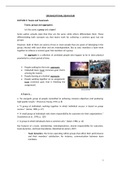ORGANIZATIONAL BEHAVIOUR
LECTURE 3: Teams and Teamwork
Teams, groups and aggregates:
Is it the same a group and a team?
Some author actually state that they are the same, while others differentiate them. Those
differentiating both concepts say that teams work for achieving a common goal, but not
groups.
However, both of them are unions of two or more people that are aware of belonging in the
group, interact with each other and are interdependent. But as said, members a team work
together to achieve a common goal. Not members of a group.
An aggregate is a collection of unrelated people who happen to be in close physical
proximity for a short period of time.
People waiting for the train: aggregate.
Volleyball team: team (common goal, that is
winning the match).
People dancing at a festival: aggregate.
People working together on an assignment:
team (common goal, that is finishing the
assignment).
A Team is …
• “An energetic group of people committed to achieving common objectives and producing
high-quality results.” (Francis & Young, 1970, p. 8)
• “A group of individuals working together in which individual success is based on group
success.” (Lanza, 1985, p. 47)
• “A small group of individuals who share responsibility for outcomes for their organizations.”
(Sundstrom et al., 1990, p. 120)
• “A group in which individuals share a common aim.” (Adair, 1986, p. vii)
Key features of a team: membership, interdependence, shared responsibility for outcomes,
team dynamics, and team boundaries. (Benishek & Lazzara, 2019
- Team dynamics: the forces operating within groups that affect their performance
and their members’ satisfaction, for instance, communication between team
members.
1
, - Team boundaries: there is always a context around the team which influences the
team.
Why do organizations use teams?
Studies say that:
• A team can achieve more than a single person.
• Cross-functional and multi-industry collaboration (specific skills, knowledge and
expertise).
• Stimulate and energize employees (obviously there are exceptions when team
working is ineffective).
• Stronger relationships between employees.
• Enhance creative solutions.
• Concurrent work reduces time.
•…
There are many more advantages supported by studies about organizations using teams.
The sense of belonging in a team:
Feeling that we are part of the team is a key element.
In relation to this idea, Hawthorne studies were performed.
The first experiment done by these studies the so-called illumination experiment: how
changing external factors (in this case, the light: low or high light, bright or dark light, etc.)
impacts productivity of workers. Even with low visibility, productivity of the team workers
increased.
Then, the Relay Assembly Test Room experiments were conducted: give the workers special
status and rewards in exchange for the work done (let them go home earlier, giving more
2





